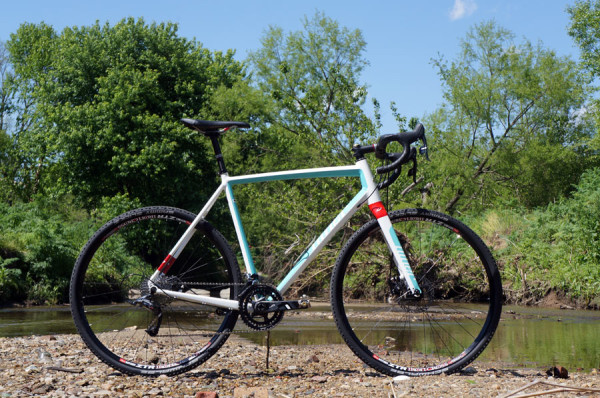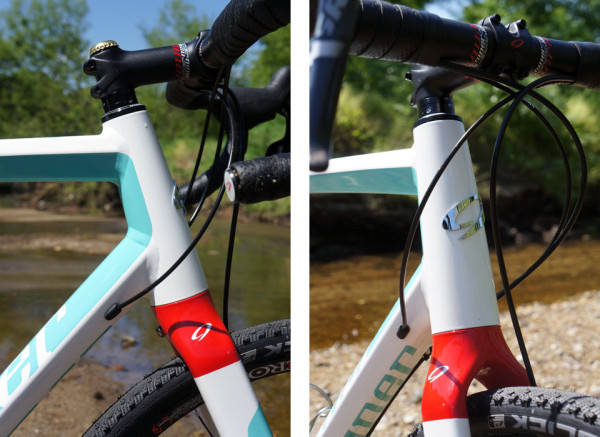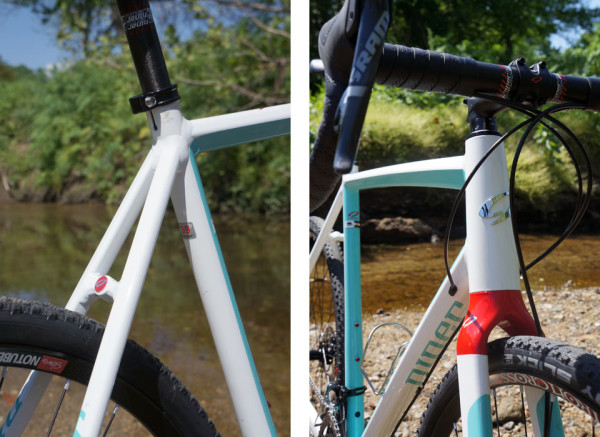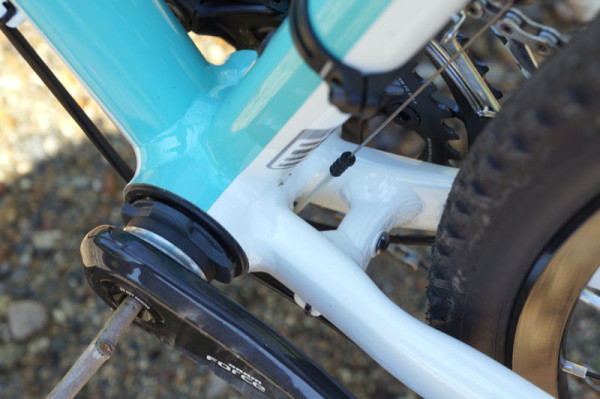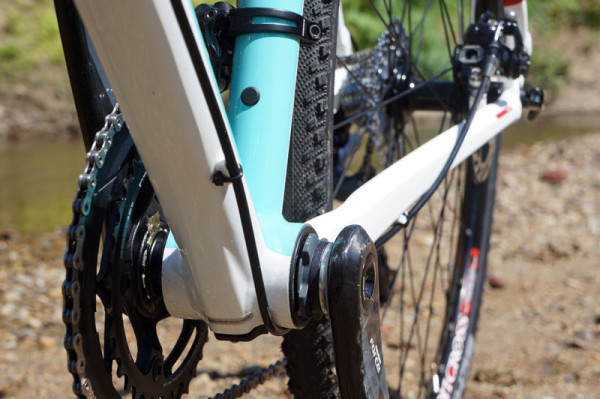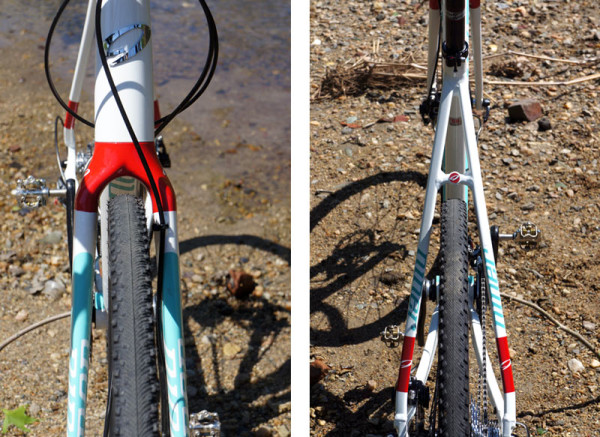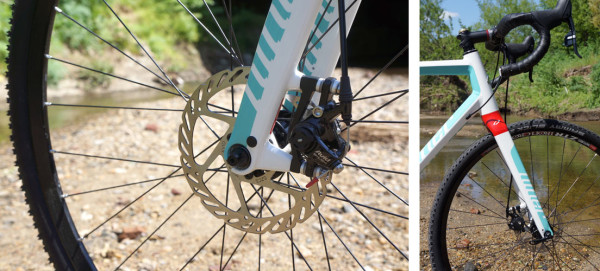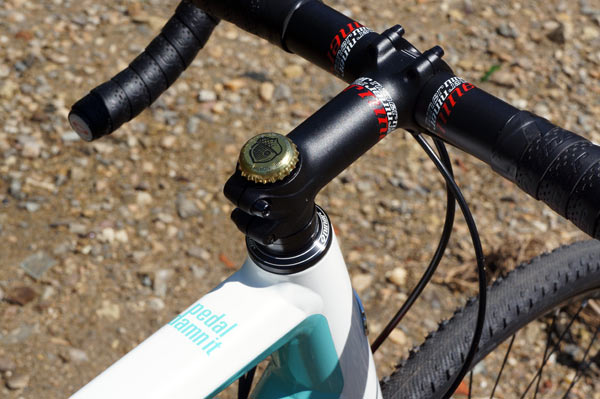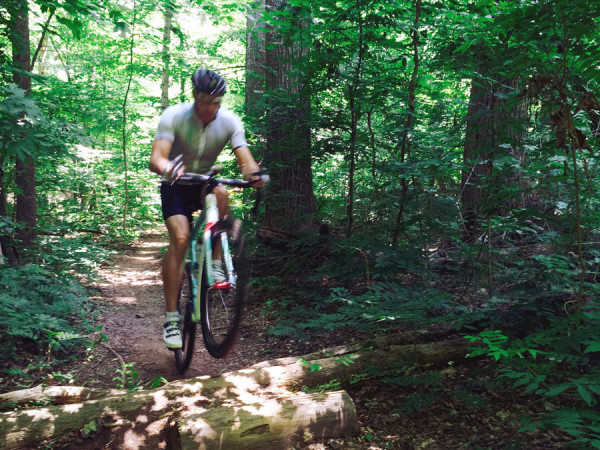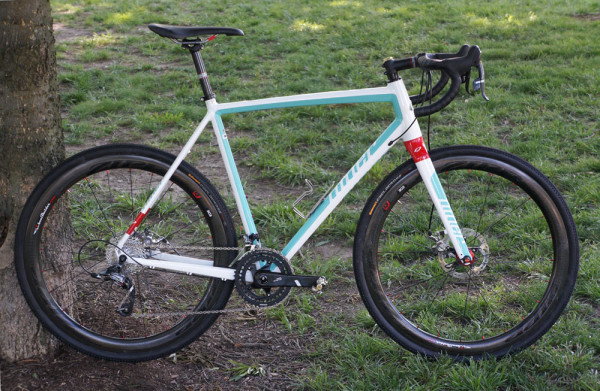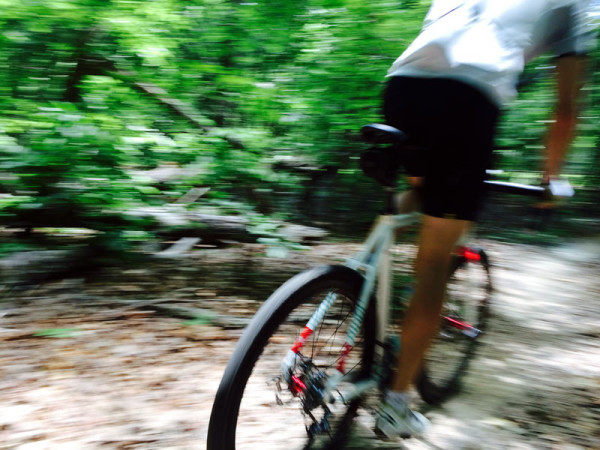Introduced last September, the Niner RLT 9 is the first non mountain bike from the heretofore 29er specific brand. Technically, they call it an “all-road mountain bike”, which, after riding it, isn’t far from the truth.
Built on a hydroformed alloy frame, the bike gets gravel road geometry with a slackish head angle and slightly longer chainstays. Think Salsa Warbird, not Ridley X-Bow, and you get the idea. While they’ve introduced a few new build kits and paint schemes, we tested the original model built with SRAM Force 22, a full Niner cockpit and Stan’s Iron Cross wheels.
Despite their mountain bike heritage, Niner managed to get a road going version very right on their first try. That doesn’t mean it can’t rip the singletrack, too…
Up front, the size 59 (tested) has a rather tall, smoothly tapered head tube that flows beautifully into their own carbon “gravel” fork. Other than the seat tube, the head tube is about the only round part of the frame.
Sharp shapes on the top- and downtubes are subtly curved to soften the lines, yet keep the bike very, very stiff. Seatstays are slightly flat, but beefy.
Chainstays aren’t oversized, but are also shaped to amplify frame stiffness. Rear brake mounts are nicely placed inside the rear triangle without requiring any odd bends or extended shaping of the seatstay. Fender and rack mounts are present without being eyesores.
Shift cables run inside the downtube then pop out under the bottom bracket shell. Rear brake hose runs externally the whole way. The frame comes with Di2 ports and can be run either electronically or mechanically with no changes. It’s spec’d for a PFBB30 bottom bracket, which also lets them use their BioCentric EBB to convert the frame to single speed.
Tire clearance is ample, with claimed clearance for a 29×1.75 (approximately 700×42). Shown here are the Schwalbe Sammy Slick 700×35 with plenty of breathing room.
Niner’s carbon forks are fairly well regarded, and the new gravel version lives up to the hype. It’s stiff and good looking and handled the rough stuff just fine. If anything, it might could use a bit more fore/aft compliance. It’s built for 140mm rotors, but the bike came with 160mm front installed. Small rubber plugs hide the fender mounts above the axle, but they fall out a bit too easily. Sorry Niner, it’ll be a few shy when it comes home.
The cockpit is all Niner. Stem and handlebar are alloy, seatpost is carbon and the saddle gets Cr-Mo rails. It’s all perfectly functional, but an alloy bar off road is a buzz kill in that it absolutely does not kill the buzz. This would be the second part I’d swap out immediately. As for the post, an upgrade to Niner’s RDO flex carbon seatpost would be a smart move, too…it works wonderfully, and the benefits will be even more appreciated on a stiff alloy frame like this. YAWYD steerer cap included, decorated here with a Red Oak cap. Mmmmmmm, Red Oak.
The complete bike (no pedals) came in at 19.36lbs (8.78kg) for a size 59.
RIDE REVIEW
Overall, the RLT 9 is very good, but I do have a few spec concerns to get out of the way first: If the handlebar was the second thing I’d swap out, the first is the wheels. Or the tires. Or both. Here’s why: The included Schwalbe Sammy Slick tires are not tubeless ready and have a printed minimum 50psi rating. Stan’s Iron Cross have a max air pressure rating of 45psi. Sure enough, as soon as the gauge hit 46, the tire blew off the rim and sprayed my office with sealant (they were sent set up tubeless, but most likely they’ll have tubes on the shop floor). I spoke with Stan’s about the issue and here’s the deal. No, it’s not the bead hook that can’t handle the higher pressures. It’s the combination of a non-tubeless tire’s bead not being designed to pop into the hook and hold tight. That’s why the tire blew off anyway, and it was more a coincidence that it happened immediately over 45psi. In reality, the 45psi max rating on the rims is because they’re using the old Alpine rim extrusion, which was originally designed as an ultralight 26″ mountain bike rim for racers running pressures in the mid 20psi range or lower. At 45psi, there’s a chance the rim can start to deform, letting the sidewalls bend outward or even split down the middle under abuse.
I tried running the tires at 40psi, but on the road and smoother gravel paths, it just felt too squishy under my 190lb person (before adding kit, water bottles, etc.). And knowing how easily the tires blew off the rim before, I simply never felt confident pushing it through the corners. So, the solution is as simple as swapping to proper tubeless tires, or switching wheels:
We have White Industries’ new CLD disc hubs in for review, which they sent laced to Zipp 303 rims. Hells yeah. That let me comfortably run 50-60psi, which seemed to be the right balance between comfort, performance and pinch flat prevention. If it were my personal bike, I’d run a tubeless set up on shallow rims (carbon or alloy).
The second spec change I’d make is the cockpit, swapping to a carbon handlebar like the Thomson KFC (which, to Niner’s credit, is spec’d on their top end build) and moving to a flex seatpost.
Why the changes? Besides the tire/rim concerns, to add a bit of comfort to the bike in ways that don’t detract from (and probably improve) it’s performance. The combination would take the edge off the aluminum frame’s inelastic ride. After all, it’s a solid frame that’s among the stiffest bikes I’ve ridden. The Zipp’s further amplified the rigid feeling when rocking the bike back and forth during sprints, but it’s the ridiculously stiff shaped alloy frame and stout carbon fork that really let you know this thing’s made to go fast. That also means bump feedback can be a bit harsh on the behind, hence the desire for tubeless and flex post. Fortunately, there’s clearance for wider tires to further mitigate chatter. The upside is I get the feeling it’ll hold up to whatever nonsense you decide to ride, be it rutted forest service roads, mountain bike trails or just good ol’ fashioned pavement.
Our size 59 had a 72º head angle. Smaller sizes get half a degree slacker per frame size as they go down, likely to improve front wheel/toe clearance. At low speeds, this provided quick handling (good for ‘cross). At cruising speed, it held a straight line with hands off the bar (good for crushing roads). The combination also worked pretty well on singletrack, weaving between trees and around switchbacks almost as well as a rigid hardtail.
The RLT 9 isn’t some timid line extension from a mountain bike brand. It’s a very good bike in its own right that works so well for such a wide variety of surfaces you may find yourself using your regular road bike less and less. I know I certainly have.
Retail for the complete RLT 9 4-Star build is $2,999 as tested. A mostly Shimano 105 build is $1,999 and the top level Ultegra Di2 bike is $5,499. Framesets, which include the carbon fork, are $1,049.
